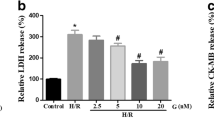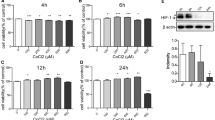Abstract
Myocardial ischemia is a severe stress condition that causes extensive biochemical changes triggering cardiac cell death. The 78-kDa glucose-regulated protein (GRP78), a heat shock protein present in all cells and a widely used marker of endoplasmic reticulum stress, functions in controlling the structural maturation of nascent glycoproteins. However, GRP78 was also found to be expressed on the cell surface of several cells such as endothelial cells, macrophages, and tumor cells where it functions as a receptor for a variety of ligands in signaling pathways. Recently, we have identified peptides from two different sources that specifically bind GRP78 protein. We have shown that binding of these peptides to endothelial cell surface GRP78 resulted in angiogenesis. In this study, we first established the presence of cell surface GRP78 on cardiac myocytes. Analysis of cardiomyocytes under hypoxia determined the significant increase in cell surface GRP78 in addition to gene expression and total protein. Apoptosis that was significantly increased in cardiomyocytes under hypoxic conditions was inhibited by the presence of the peptide-binding GRP78 during hypoxia. Inhibition of apoptosis was mediated by the binding of the peptide to cardiomyocytes cell surface GRP78 resulting in blocking caspase-3/7 activation. Silencing GRP78 RNA that reduced GRP78 receptor abrogated the peptide activity. Apoptosis of cardiac cells induced by myocardial infarction in a mouse model was also significantly inhibited by the administration of the peptide to mouse hearts. Our findings may make ADoPep1 a useful therapeutic tool for relieving of ischemia.







Similar content being viewed by others
References
Ostadal B (2009) The past, the present and the future of experimental research on myocardial ischemia and protection. Pharmacol Rep 61:3–12
Szegezdi E, Duffy A, O'Mahoney ME, Logue SA, Mylotte LA, O'Brien T, Samali A (2006) ER stress contributes to ischemia-induced cardiomyocyte apoptosis. BBRC 349:1406–1411
Pan XH, Wu C, Yuan WJ, Lin L (2007) Delayed cytoprotection induced by hypoxic preconditioning in cultured neonatal rat cardiomyocytes: role of GRP78. Life Sci 81:1042–1049
Schröder M, Kaufman RJ (2005) The mammalian unfolded protein response. Annu Rev Biochem 74:739–789
Reddy RK, Mao C, Baumeister P, Austin RC, Kaufman RJ, Lee AS (2003) Endoplasmic reticulum chaperone protein GRP78 protects cells from apoptosis induced by topoisomerase inhibitors: role of ATP binding site in suppression of caspase-7 activation. J Biol Chem 278:20915–20924
Fu HY, Minamino T, Tsukamoto O, Sawada T, Asai M, Kato H, Asano Y, Fujita M, Takashima S, Hori M, Kitakaze M (2008) Overexpression of endoplasmic reticulum-resident chaperone attenuates cardiomyocyte death induced by proteasome inhibition. Cardiovasc Res 79:547–548
Thuerauf DJ, Marcinko M, Gude N, Rubio M, Sussman MA, Glembotski CC (2006) Activation of the unfolded protein response in infracted mouse heart and hypoxic cultured cardiac myocytes. Circ Res 99:275–282
Shintani-Ishida K, Nakajima M, Uemura K, Yoshida K (2006) Ischemic preconditioning protects cardiomyocytes against ischemic injury by inducing GRP78. BBRC 345:1600–1605
Hayashi T, Saito A, Okuno S, Ferrand-Drake M, Chan PH (2003) Induction of GRP78 by ischemic preconditioning reduces endoplasmic reticulum stress and prevents delayed neuronal cell death. J Cereb Blood Flow Metab 23:949–961
Martindale JJ, Fernandez R, Thuerauf D, Whittaker R, Gude N, Sussman MA, Glembotski CC (2006) Endoplasmic reticulum stress gene induction and protection from ischemia/reperfusion injury in the hearts of transgenic mice with a tamoxifen-regulated form of ATF6. Circ Res 98:186–1193
Pan XY, Lin L, Ren AJ, Pan XJ, Chen H, Tang CS, Yuan WJ (2004) HSP70 and GRP78 induced by endothelin-1 pretreatment enhance tolerance to hypoxia in cultured neonatal rat cardiomyocytes. J Cardiovasc Pharmacol 44:S117–S120
Zhang PL, Lun M, Teng J, Huang J, Blasick TM, Yin L, Herrera GA, Cheung JY (2004) Preinduced molecular chaperones in the endoplasmic reticulum protect cardiomyocytes from lethal injury. Ann Clin Lab Sci 34:449–457
Sun Y, Liu G, Song T, Liu F, Kang W, Zhang Y, Ge Z (2008) Upregulation of GRP78 and caspase-12 in diastolic failing heart. Acta Biochim Pol 55:511–516
Arap MA, Lahdenranta J, Mintz PJ, Hajitou A, Sarkis AS, Arap W, Pasqualini R (2004) Cell surface expression of the stress response chaperone GRP78 enables tumor targeting by circulating ligands. Cancer Cell 3:275–284
Davidson DJ, Haskell C, Majest S, Kherzai A, Egan DA, Walter KA, Schneider A, Gubbins EF, Solomon L, Chen Z et al (2005) Kringle 5 of human plasminogen induces apoptosis of endothelial and tumor cells through surface-expressed glucose-regulated protein 78. Can Res 65:4663–4672
Misra UK, Sharma T, Pizzo SV (2005) Ligation of cell surface-associated glucose-regulated protein 78 by receptor-recognized forms of alpha 2-macroglobulin: activation of p21-activated protein kinase-2-dependent signaling in murine peritoneal macrophages. J Immunol 175:2525–2533
Bruneel A, Labas V, Mailloux A, Sharma S, Royer N, Vinh J, Pernet P, Vaubourdolle M, Baudin B (2005) Proteomics of human umbilical vein endothelial cells applied to etoposide-induced apoptosis. Proteomics 5:3876–3884
Hardy B, Battler A, Weiss C, Kudasi O, Raiter A (2008) Therapeutic angiogenesis of mouse hind limb ischemia by novel peptide activating GRP78 receptor on endothelial cells. Biochem Pharmacol 75:891–899
Raiter A, Weiss C, Bechor Z, Ben-Dor I, Battler A, Kaplan B, Hardy B (2010) Activation of GRP78 on endothelial cell membranes by an ADAM15 derived peptide induces angiogenesis. J Vasc Res 47:399–411
Zhang Y, Liu R, Ni M, Gill P, Lee AS (2010) Cell surface relocation of the endoplasmic reticulum chaperone and unfolded protein response regulator GRP78/Bip. Biol Chem 285:15065–15075
Gonzalez-Gronow M, Selim MA, Papalas J, Pizzo SV (2009) GRP78: a multifunctional receptor on the cell surface. Antioxid Redox Signal 11:2209–2306
Kelber A, Panopoulos AD, Shani G, Booker EC, Belmonte JC, Vale WW, Gray PC (2009) Blockade of Cripto binding to cell surface GRP78 inhibits oncogenic Cripto signaling via MAPK/PI3K and Smad2/3 pathways. Oncogene 28:2324–2336
Hardy B, Raiter A, Weiss C, Kaplan B, Tenenbaum A, Battler A (2007) Angiogenesis induced by novel peptides selected from a phage display library by screening human vascular endothelial cells under different physiological conditions. Peptides 28:691–701
Raiter A, Bechor Z, Kleiman M, Leshem-Lev D, Battler A Hardy B (2010) Angiogenic peptides improve blood flow and promote capillary growth in a diabetic and ischemic mouse model. Euro J Vasc Endovasc Surg (in press)
Sreejit P, Kumar S, Verma RS (2008) An improved protocol for primary culture of cardiomyocyte from neonatal mice. In Vitro Cell Dev Biol Anim 44:45–50
Mani SK, Balasubramanian S, Zavadzkas JA, Jeffords LB, Rivers WT, Zile MR, Mukherjee R, Spinale FG, Kuppuswamy D (2009) Calpain inhibition preserves myocardial structure and function following myocardial infarction. Am J Physiol Heart Circ Physiol 297:H1744–H1751
Marketou M, Kintsurashvili E, Papanicolaou KN, Lucero HA, Gavras I, Gavras H (2010) Cardioprotective effects of a selective B2 receptor agonist of bradykinin post-acute myocardial infarct. Am J Hypertens 23:562–568
Vitadello M, Penzo D, Petronilli V, Michieli G, Gomirato S, Menabo S, Di Lisa F, Gorza L (2003) Overexpression of the stress protein GRP94 reduces cardiomyocyte necrosis due to calcium overload and stimulated ischemia. FASEB J 17:923–925
Bhimji S, Godin DV, McNeill JH (1986) Coronary artery ligation and reperfusion in alloxan-diabetic rabbits: ultrastructural and haemodynamic changes. Brit J Exp Pathol 67:851–863
Suzuki T, Lu J, Zahed M, Kita K, Suzuki N (2007) Reduction of GRP78 expression with siRNA activates unfolded protein response leading to apoptosis in HELA cells. Arch Bioch Biophs 468:1–14
Telger E, Dam TV, Richard L, Wisnewski C, Tea BS, Gaboury L, Tremblay J, Swartz K, Hamet P (1996) Apoptosis in pressure overload induced heart hypertrophy in the rat. J Clin Invest 97:2891–2897
Katare RG, Ando M, Kakinuma Y, Arikawa M, Yamasaki F, Sato T (2010) Differential regulation of TNF receptors by vagal nerve stimulation protects heart against acute ischemic injury. J Mol Cell Cardiol 49:234–244
Wang M, Tan J, Wang Y, Meldrum KK, Dinarello C, Meldrum DR (2009) IL-18BP MSCs enhanced cardioprotection after myocardial infarction. Proc Natl Acad Sci 106:17499–17504
Acknowledgments
The authors wish to express their gratitude to Ms. Sara Dominitz for her excellent editorial assistance and to Ms. Moran Kleman for her high expertise in statistical analysis.
Sources of funding
This work was funded by the Tel-Aviv University Research Grant.
Disclosures
None.
Author information
Authors and Affiliations
Corresponding author
Rights and permissions
About this article
Cite this article
Hardy, B., Raiter, A. Peptide-binding heat shock protein GRP78 protects cardiomyocytes from hypoxia-induced apoptosis. J Mol Med 88, 1157–1167 (2010). https://doi.org/10.1007/s00109-010-0657-7
Received:
Revised:
Accepted:
Published:
Issue Date:
DOI: https://doi.org/10.1007/s00109-010-0657-7




